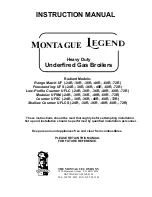
18
| PSH Trend www.stiebel-eltron.com
INSTALLATION
Commissioning
10.1.2 Fitting the safety valve
Note
The safety valve supplied must not be used in Belgium.
For use here please use standard safety valves (see also
pricelist).
Note
If the water pressure is greater than 0.6 MPa, install a
pressure reducing valve in the "cold water inlet".
The maximum permissible pressure must not be exceeded (see
chapter "Specification / Data table").
f
Install a type-tested safety valve in the cold water supply
line. Please note that, depending on the static pressure, you
may also need a pressure reducing valve.
f
Size the drain so that water can drain off unimpeded when
the safety valve is fully opened.
f
Fit the discharge pipe of the safety valve with a constant
downward slope and in a room free from the risk of frost.
f
The safety valve discharge aperture must remain open to the
atmosphere.
10.2 Power supply
WARNING Electrocution
Carry out all electrical connection and installation work
in accordance with relevant regulations.
Before any work on the appliance, disconnect all poles
from the power supply.
WARNING Electrocution
Only use a permanent connection to the power supply.
The appliance must be able to be separated from the
power supply by an isolator that disconnects all poles
with at least 3 mm contact separation.
WARNING Electrocution
Ensure that the appliance is earthed.
Material losses
Install a residual current device (RCD).
!
Material losses
Observe the type plate. The specified voltage must match
the mains voltage.
Power cable
DANGER Electrocution
The power cable must only be replaced (for example
if damaged) with the original spare part by a qualified
contractor authorised by the manufacturer.
The appliance is supplied with a flexible power cable with wire
ferrules and without plug, ready to connect.
f
If the power cable is of insufficient length, unclamp it from
the appliance. Use a suitable installation cable.
f
When routing the new power cable, ensure that it is water-
proof as it passes through the existing cable grommet, and is
correctly routed and connected inside the appliance.
11. Commissioning
11.1 Commissioning
Note
Fill the appliance with water prior to electrical connec-
tion. If you switch on the appliance while empty, the high
limit safety cut-out will switch it off.
f
Thoroughly flush out the cold water line before connecting
the appliance, so that no foreign matter gets into the water
heater or safety valve.
f
Open the shut-off valve in the cold water feed line.
f
Open a draw-off point until the appliance has filled up and
the pipework is free of air.
f
Adjust the flow rate. For this, observe the maximum permis-
sible flow rate with a fully opened tap (see chapter "Specifi-
cation / Data table").
f
If necessary reduce the flow rate at the butterfly valve of the
safety valve.
f
Turn the temperature selector to maximum.
f
Switch the mains power ON.
f
Check the function of the appliance. Ensure that the thermo-
stat switches off.
f
Check that the safety valve is working correctly.
11.1.1 Appliance handover
f
Explain the function of the appliance and safety valve to
users and familiarise them with their operation.
f
Make users aware of potential dangers, especially the risk of
scalding.
f
Hand over these instructions.
11.2 Recommissioning
See chapter "Commissioning".
12. Shutting down
f
Disconnect the appliance from the mains at the MCB/fuse in
the fuse box.
f
Drain the appliance. See chapter "Maintenance / Draining the
appliance".
















































